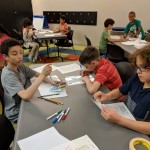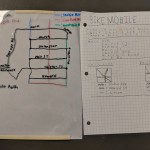This summer our STEAM space, the BOOMbox, is exploring engineering. We’re focusing on a different field of engineering every two weeks to help kids understand the breadth and overlap of this STEAM topic. While the BOOMbox offers drop-in experiences, our Be the Scientist program series for grades 3-5 provided a more structured exploration of civil engineering, specifically looking at bike paths in Skokie. Here’s what we did.
We began with a short slide presentation to start discussion about what engineering is and why it is valuable. We also reviewed the seven steps of engineering design from Engineered! Engineering Design at Work by Shannon Hunt and James Gulliver Hancock to help kids understand that designing and making things is an iterative process, both in the library and the real world. We then moved the discussion to talk specifically about civil engineering, what it is and where we see it in our everyday lives.
This helped transition the focus to our community as the next discussion question asked how civil engineering could be applied in Skokie to improve living conditions. We’re fortunate that participants were willing to share ideas, including implementing a robot to clean up mud in school hallways after it rains. And to help steer the discussion towards the program’s challenge, we asked: does anybody ride a bike? All hands went up and we used that to segue to the challenge of designing a safe bike or walking route from specific destinations in Skokie.
To complete the challenge, participants were provided with copies of the street map and existing bike routes in Skokie. They used acetate sheets taped over these maps to draw and often re-draw their routes. As with many Be the Scientist programs, some participants started right away on their routes, brainstorming ideas as they drew, while others needed more guidance or at least a starting point. For those kids who needed more help, we asked where a safer bike or walking route would be most helpful for them, if it was from their home to school or from school to the library. And in one instance, we encouraged a participant to use the supplies to draw and label their idea for a different civil engineering project.
As kids finished up their drafts, we welcomed them to share their ideas and reasoning with the group. One participant was so inspired by the library’s upcoming bike mobile that he decided to design routes for it, suggesting using streets that were most populated and crossed fewer busy streets.
We wanted to experiment with this program since it focused on a field of engineering that has daily impact but not as much awareness by kids. We also liked exposing kids to actual maps, helping them find where they live and then orient themselves to a destination. While it may not be a flashy topic, it did welcome meaningful discussion between participants and we hope you consider giving it a try in your community.






Hi Amy–I work for the American Society of Civil Engineers. You might want to connect with the Illinois Section of the ASCE. ASCE is working with StarNet/SSI on an initiative to have local engineers help with library programming. If interested, please contact outreach@asce.org and we will forward your info to your local group. We might want to share this through our network, so please get in touch!